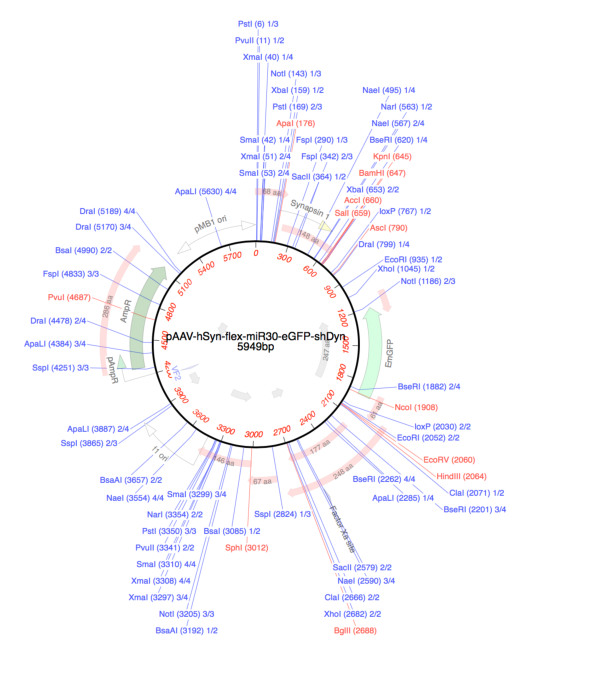AAV8-hSyn-flex-miR30-eGFP-shDyn
(Plasmid
#132716)
-
PurposeEncodes Cre-dependent short hairpin RNA (shRNA) that targets the 3’-untranslated region of the rat Pdyn gene, which encodes dynorphin
-
Depositing Lab
-
Sequence Information
Ordering
| Item | Catalog # | Description | Quantity | Price (USD) | |
|---|---|---|---|---|---|
| Plasmid | 132716 | Standard format: Plasmid sent in bacteria as agar stab | 1 | $85 | |

Want a viral vector made from this plasmid?
Make a packaging request and we'll get back to you.
Please log in to submit a packaging request.
-
SerotypeSelect serotype for details See details about
-
PricingSelect serotype and quantity $ USD for preparation of µL virus + $30 USD for plasmid.
-
How this works
- Place a request for a quantity of 10 (1 mL), 25 (2.5 mL), or 50 (5 mL). Our all-inclusive pricing includes DNA production and QC.
- Addgene will quickly confirm that we can produce a high-quality prep for you.
- Track your request and place an order from within your account. Payment information must be added before we can begin processing your order.
- Receive your prep in 6–9 weeks after the MTA is approved by your organization.
- Learn more about our Packaged on Request Service.
Backbone
-
Vector backbonepAAV-hSyn-flex-miR30
-
Backbone manufacturerAddgene Plasmid #6745
- Backbone size w/o insert (bp) 4811
- Total vector size (bp) 5950
-
Vector typeAAV
Growth in Bacteria
-
Bacterial Resistance(s)Ampicillin, 100 μg/mL
-
Growth Temperature37°C
-
Growth Strain(s)NEB Stable
-
Copy numberLow Copy
Gene/Insert
-
Gene/Insert nameGFP-shDyn
-
Alt nameGFP-shCrh fragment from pPRIME-CMV-GFP- shDyn(1) vector
-
SpeciesR. norvegicus (rat)
-
Insert Size (bp)1138
-
GenBank IDNM_019374
-
Entrez GenePdyn
- Promoter Synapsin 1
Cloning Information
- Cloning method Restriction Enzyme
- 5′ cloning site AscI (not destroyed)
- 3′ cloning site NheI (not destroyed)
- 5′ sequencing primer TGCCTGAGAGCGCAGTCG
- 3′ sequencing primer AGCAGCGTATCCACATAGCG (Common Sequencing Primers)
Terms and Licenses
-
Academic/Nonprofit Terms
-
Industry Terms
- Not Available to Industry
Trademarks:
- Zeocin® is an InvivoGen trademark.
These plasmids were created by your colleagues. Please acknowledge the Principal Investigator, cite the article in which the plasmids were described, and include Addgene in the Materials and Methods of your future publications.
-
For your Materials & Methods section:
AAV8-hSyn-flex-miR30-eGFP-shDyn was a gift from Robert Messing (Addgene plasmid # 132716 ; http://n2t.net/addgene:132716 ; RRID:Addgene_132716) -
For your References section:
Dissecting the Roles of GABA and Neuropeptides from Rat Central Amygdala CRF Neurons in Anxiety and Fear Learning. Pomrenze MB, Giovanetti SM, Maiya R, Gordon AG, Kreeger LJ, Messing RO. Cell Rep. 2019 Oct 1;29(1):13-21.e4. doi: 10.1016/j.celrep.2019.08.083. 10.1016/j.celrep.2019.08.083 PubMed 31577943





